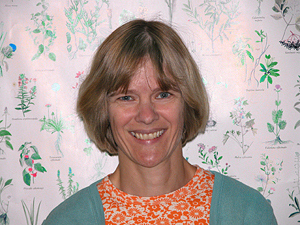Patricia Conklin, Professor

- Office: Bowers Hall, Room 1324
- Lab: Bowers Hall, Room 1323
- Phone: 607-753-2717
- Email: patricia.conklin@cortland.edu
Education
Allegheny College, B.S.
Cornell University, Ph.D.
Courses Frequently Taught
Genetics
Human Genetics
Molecular Genetics
Scholarly Interests
Highly damaging reactive oxygen species (ROS) are generated by a wide variety of factors in plants. High light can result in photo-oxidative damage when ROS generated during photosynthesis exceed that of the antioxidant capacity. Such conditions occur when high light is combined with drought, temperature extremes, or nutrient deprivation. Other abiotic factors in the plant’s environment also lead to increased ROS including UV-B, air pollutants, certain herbicides, and phytotoxic metals. I have a general interest in understanding how plants protect themselves against ROS.
The current research focus of my laboratory is on vitamin C (ascorbic acid), a crucial antioxidant and cellular reductant in both plants and animals and an essential component of the human diet. Despite the importance of this small molecule in plant physiology and animal health, only very recently has significant progress been made toward understanding how plants synthesize ascorbic acid. To identify genes involved in this biosynthetic pathway we have isolated Arabidopsis thaliana mutants that are deficient in ascorbic acid. One of these mutants was isolated by virtue of its sensitivity to ozone and has led to the isolation of a gene that encodes a key ascorbic acid biosynthetic enzyme. We are currently cloning additional genes involved in the synthesis of ascorbic acid. Our research on plant antioxidants has potential downstream applications in the areas of plant environmental stress tolerance and human health.
In addition, a new initiative on plant folic acid biosynthesis has begun in my laboratory in collaboration with colleagues at the Boyce Thompson Institute at Cornell University.
Those interested in learning more about Arabidopsis thaliana (the model plant for many plant molecular genetic studies) can check out The Arabidopsis Information Resource (TAIR).
Selected Publications
Hanson MR, Conklin PL.
Stromules, functional extensions of plastids within the plant cell.
Curd Opin Biol. 2020 Dec;58:25-32. doi: 10.1016/j.pbi,=.2020.10.005. Epub 2020 Nov 1.PMID: 33137706.
Conklin PL, DePaolo D, Winter B, Schatz C, Buckenmeyer G.
J Exp Bot. 2013 Jul;64(10):2793-804. doi: 10.1093.jxb.ert140. Epub 2013 Jun 7.PMID: 23749562
Barth C, De Tullio M, Conklin PL.
The role of ascorbic acid in the control of flowering time and the onset of senescence.
J exp Bot. 2006;57(8): 1657-65. doi: 10.1093/jxb.erj198 Epub 2006 May 12.PMID: 16698812.
Conklin PL, Gatzek S, Wheeler GL, Doodle J, Raymond MJ, Rowinski S, Isupov M, Little child JA, Smirnoff N.
J Biol Chem. 2006 Jun 9;281(23):15662-70. doi: 10.1074/jbc.M601409200 Epub 2006 Apr 4.PMID: 16595667.
Barth C, Modder W, Klessig DF, Conklin PL. Plant Physiol. 2004 Apr;134(4):1784-92.
doi: 10.1104/pp.103.032185. Epub 2004 Apr 2.PMID: 15064386.
Barth C, Conklin PL, Plant J. 2003 Jul;35(2):206-18
The lower cell density of leaf parenchyma in th eArabidopsis thaliana mutant lcd 1-1 is associated with increased sensitivity to ozone and virulent Pseudomonas syringae. doi: 10.1046/j.1365-313x.2003.01795.x PMID: 12848826.
Müller-Modulé P, Conklin PL, Niyogi KK. Plant Physiol. 2002 Mar;128(3):970-7.
Ascorbate deficiency can limit violaxanthin de-epoxidase activity in vivo. doi:10.1104/pp.010924. PMID: 11891252.
Smirnoff N, Conklin PL, Loewus FA. Annu Rev Plant Physiol Plant Mol Biol. 2001 Jun;52:437-467
BIOSYNTHESIS OF ASCORBIC ACID IN PLANTS: a Renaissance. doi:10.1146/annurev.arplant,52.1.437. PMID: 11337405
Lukowitz W, Nicole TC, Meineke DW, Last RL, Conklin P.L., Sommerville CR. Proc Natl Acad Sci USA 2001 Feb 27;98 2262-7
Arabidopsis cyt1 mutants are deficient in a mannose-1-phosphate guanylyltransferase and point to a requirement of N-linked glycosylation for cellulose biosynthesis. doi 10.1073/pnas.051625798. Epub 2001 Feb 20. PMID: 11226227
Conklin, P.L., S.A. Saracco, S.R. Norris and R.L. Last (2000) Identification of vitamin C-deficient Arabidopsis thaliana mutants.
Genetics, 154: 847-856.
Conklin, P.L., S.R. Norris, G.L. Wheeler, E.H. Williams, N. Smirnoff and R.L. Last (1999)
Genetic evidence for the role of GDP-mannose in plant ascorbic acid(vitamin C) biosynthesis
Proc Natl Acad Sci USA 96: 4198-4203.
Conklin, P.L. (1998) Vitamin C: a new pathway for an old antioxidant. Trends Plant Sci 3: 329-330.
Conklin, P.L., J.E. Pallanca, R.L. Last and N. Smirnoff. (1997) L-ascorbic acid metabolism in the ascorbate deficient Arabidopsis mutant. Plant Physiol 115: 1277-1285.
Conklin, P.L., E.W. Williams and R.L. Last. (1996) Environmental stress sensitivity of an ascorbic acid-deficient Arabidopsis mutant. Proc Natl Acad Sci USA 93: 9970-9974.
Conklin, P.L. and R.L. Last (1995) Differential accumulation of antioxidant enzyme mRNAs in Arabidopsis thaliana exposed to ozone.
Plant Physiol 109: 203-212.